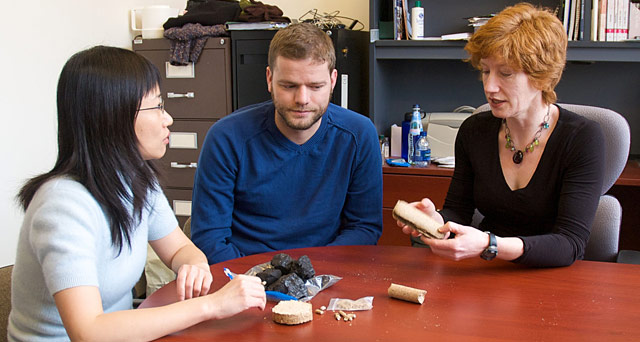
Wood pellets displace conventional fossil fuels

By Janet Wong
Using wood pellets in place of coal to fire Ontario’s power plants reduces their output of greenhouse gas emissions by as much as 91 per cent, says new research from the Faculty of Applied Science and Engineering.
“Our study investigates, on a life cycle basis, 100 per cent wood pellet firing and co-firing with coal in two coal power-generating stations in Ontario,” said Professor Heather MacLean of U of T’s Civil Engineering Department and lead author of a study in the January 2010 edition of Environmental Science and Technology. “The results were significant. We found that greenhouse gases from these power plants were reduced by 91 per cent when employing wood pellets instead of coal, and 78 per cent when using wood in place of a natural gas combined cycle.”
The wood pellets used in the study were made from roundwood harvested from the Great Lakes-St. Lawrence forest region. The researchers compared greenhouse gases (GHG) and some air pollutant emissions of wood pellets with those resulting from current coal and hypothetical natural gas power plants. Their analysis included the impact from resource extraction (coal mining, natural gas production or forest harvesting), fuel processing, transportation to the generating station and combustion to produce electricity.
“Our study is the first one that analyzes 100 per cent biomass usage in coal generation power stations,” said MacLean. “The results from the analysis are expected to provide valuable insights for decision making in the sustainable development of future electricity generation systems.”

Prof. MacLean examines samples of coal and wood with CivE graduate students Yimin Zhang and Jon McKechnie.
Coal electricity generation was responsible for 15 per cent of Ontario’s total GHG emissions in 2007. The Ontario government has committed to eliminating the use of coal for electricity generation by Dec. 31, 2014. In contrast, the European Union has rules requiring member countries to generate 20 per cent of their electricity from renewable sources by 2020 and wood pellets are currently used for electricity generation in Europe. Some utilities in the United States are now beginning to use wood pellets. Currently, there are no utilities in Canada that use wood pellets as a renewable energy resource.
“Wood pellets, provided they are sustainably and responsibly produced, are a low-GHG fuel that can effectively displace conventional fossil fuels in electricity generation or for thermal applications such as heating or hot water,” said MacLean. “Biomass co-firing and 100 per cent biomass usage should be considered along with other options such as wind or solar technology for electricity generation to reduce GHG emissions and increase renewable electricity generation.”
However, she acknowledges that biomass may not be economically competitive for electricity production except in niche markets where forestry harvesting occurs in abundance and costs are low. To make significant gains in reducing GHG emissions, a combination of conservation, efficiency improvement and renewable energy sources is needed.
While using coal to generate electricity is the lowest cost option, it is also the most environmentally detrimental. As our society transitions to a more sustainable economy, it is important to consider both the costs and benefits of alternatives that can lead us along this transition path, MacLean said. “Evaluating the merits of using wood pellets for electricity generation requires a weighing of the issues, in particular: How great are the environmental benefits this method can achieve? How great are the economic costs to implement the method? How does this method compare to other sustainable alternatives? This is the sort of thinking that must be undertaken by policy makers whose job is to decide what the energy sector of tomorrow should look like,” she notes.
“Climate change and reducing greenhouse gas emissions are some of the critical issues facing the world today,” said Professor Cristina Amon, Dean of the Faculty of Applied Science and Engineering. “When it comes to these pressing issues, our faculty and engineers are at the forefront of environmental research. This study led by Professor MacLean provides policy makers and governments with data that will help them make informed decisions about the potential and feasibility of this type of renewable energy.”
Using wood pellets in place of coal to fire power plants, however, is only part of the solution to lowering Canada’s output of greenhouse gases, MacLean adds. Coal-fired electricity generation was responsible for about 13 per cent of GHG emissions in 2006 in Canada – 95.1 million tonnes of carbon dioxide equivalents (CO2-eq). “Converting all of these plants to wood pellets would eliminate the vast majority of these emissions. Assuming a 91 per cent reduction in GHG emissions, as estimated in our study, about 86.5 million tonnes of GHG emissions could be reduced through switching to 100 per cent pellets firing, provided that adequate biomass was available to produce that quantity of pellets and that the impact on forest carbon storage was not great,” she said.
But coal-fired electricity generation is only one source of GHG in Canada. Canada’s goal is to reduce its GHG emissions by 20 per cent from 2006 levels by 2020 – a reduction of 144 million tonnes of CO2-eq. Canada’s total GHG emissions in 2006 was 721 million tonnes of CO2-eq. Therefore, notes MacLean, meeting or exceeding aggressive GHG emission reduction targets would require an economy-wide effort. “There is no silver bullet in tackling climate change. Targets will only be met through the combined contribution of many smaller-scale solutions, of which wood pellets is just one.”
MacLean is also cross-appointed to the Department of Chemical Engineering and Applied Chemistry and the School of Public Policy and Governance at U of T. She conducted this research with Yimin Zhang and Jon McKechnie of U of T’s Civil Engineering Department, Denis Cormier of FPInnovations-FERIC, Robert Lyng of Ontario Power Generation, Warren Mabee of the School of Policy Studies and the Department of Geography at Queen’s University, and Akifumi Ogino of the National Agriculture and Food Research Organization in Japan.
The research was supported by Ontario Power Generation and the Natural Sciences and Engineering Research Council.
Newsletter Archives
Did you miss a past issue of the Engineering Newsletter? Revisit past articles and catch up on Faculty news on the Engineering homepage.
The Engineering Newsletter is a twice-monthly summary of key headlines, events and opportunities for faculty and staff in the Faculty of Applied Science and Engineering. If you have questions or comments, please contact us: dean.engineering@ecf.utoronto.ca.
Follow us on Twitter: http://twitter.com/uoftengineering